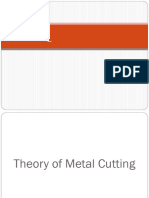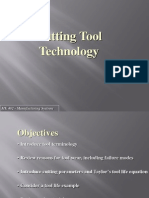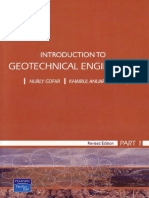ME 338 Manufacturing Processes II HW#1
Uploaded by
Aditya DaveME 338 Manufacturing Processes II HW#1
Uploaded by
Aditya DaveME 338
Manufacturing Processes II
HW#1
Instructor: Ramesh Singh
Assigned Date: Sept 6, 2009
Due Date: Sept 11, 2009
1. Assume the tool-workpiece contact to be a parallel spring damper system as shown in Fig. 1.
Fig. 1. Tool-workpiece spring damper system
+ + =
Viscous damping ratio, =
a) For free vibrations (F(t)=0), solve the differential equation and plot solutions for
critically damped(=1) and underdamped(<1)
b) Machine tools encounter unit impulse, unit step and periodic force functions which may
excite vibration in the machine.
Assuming F(t) to be unit impulse function and unit step function, plot their responses for
the spring-damper system for a critically damped condition (=1) and make
observations on the differences.
2. You are grinding a steel, which has a specific grinding energy (u) of 25 W-s/mm
3
. The
grinding wheel rotates at 3000 rpm, has a diameter (D) of 120 mm, thickness (b) of 20 mm,
and (c) 5 grains per mm
2
(c). The motor has a power of 2 kW. The work piece moves (v) at
1.5 m/min. The chip thickness ratio (r) is 10.
a) Determine the grinding force and force per grain.
b) Determine the temperature (K
2
is 0.2
o
K-m/N). Room temperature is 20
o
C.
Let the grain be a SiC grain modeled as a continuously varying circular beam as shown in
Fig. 2. Assume the force/grain is acting at the tip and the bonding is perfect. Use cantilever
beam theory to find maximum stress. Will these stresses be sufficient to fail the grain? Look
up all the properties of SiC.
3. Machining Economics
a) Derive the optimal cutting v
b) Find optimal cutting velocity and tool life for maximum profit
rate for the following conditions.
Given:
Taylor tool life equation
Machining (turning) parameters
Depth of cut, d = 1.00 mm
Feed, f = 0.2 mm/rev
Workpiece geometry
Workpiece diameter,
Workpiece length,
Time parameters
Setup time,
Tool replacement time,
Cost parameters
Machine utilization rate,
Machining overhead,
Tool cost,
Fig. 2. SiC grain geometry.
Derive the optimal cutting velocity and tool life for lowest unit cost.
elocity and tool life for maximum profit and maximum production
rate for the following conditions.
Taylor tool life equation VT
0.3
= 400, V (m/min)
Machining (turning) parameters
= 1.00 mm
= 0.2 mm/rev
Workpiece geometry
Workpiece diameter, D = 50 mm
Workpiece length, L = 200 mm
Setup time, t
p
= 0.80 min/pt
Tool replacement time, t
c
= 1.5 min/edge
Machine utilization rate, k
o
= 0.50 $/min
Machining overhead, k
m
= 0.05 $/min
Tool cost, k
t
= 2.50 $/edge
and maximum production
You might also like
- Shin-Nippon SLM-4000-5000 - Service Manual PDFNo ratings yetShin-Nippon SLM-4000-5000 - Service Manual PDF46 pages
- 2016 03 01 - Lecture 6 Forces and EnergyNo ratings yet2016 03 01 - Lecture 6 Forces and Energy12 pages
- EMMU 7244-Machine Tool Vibrations and Cutting Dynamics-Exam July 2016No ratings yetEMMU 7244-Machine Tool Vibrations and Cutting Dynamics-Exam July 20164 pages
- Manufacturing Technology.docx-paper TypeNo ratings yetManufacturing Technology.docx-paper Type12 pages
- Economics and Product Design ConsiderationsNo ratings yetEconomics and Product Design Considerations3 pages
- ESE-2018 Mains Test Series: Mechanical Engineering Test No: 15No ratings yetESE-2018 Mains Test Series: Mechanical Engineering Test No: 1538 pages
- ME - 32021 Chapter (10) Economics of Machining Processes100% (3)ME - 32021 Chapter (10) Economics of Machining Processes18 pages
- Session 3 - Manufacturing Processes and PracticesNo ratings yetSession 3 - Manufacturing Processes and Practices22 pages
- CAT I - EMMU 7241 - Machine Tool Vibrations and Cutting DynamicsNo ratings yetCAT I - EMMU 7241 - Machine Tool Vibrations and Cutting Dynamics2 pages
- ENS6134-Equation Sheet For Final ExaminationNo ratings yetENS6134-Equation Sheet For Final Examination4 pages
- EMMU 7244-Machine Tool Vibrations and Cutting Dynamics-Exam July 2016No ratings yetEMMU 7244-Machine Tool Vibrations and Cutting Dynamics-Exam July 20164 pages
- Finite Element Modeling of High Speed Milling 7050 T - 2020 - Procedia ManufactuNo ratings yetFinite Element Modeling of High Speed Milling 7050 T - 2020 - Procedia Manufactu8 pages
- Cutting Tool Technology: ME 482 - Manufacturing SystemsNo ratings yetCutting Tool Technology: ME 482 - Manufacturing Systems25 pages
- Cutting Tool Technology: ME 482 - Manufacturing SystemsNo ratings yetCutting Tool Technology: ME 482 - Manufacturing Systems25 pages
- Cutting Tool Technology: ME 482 - Manufacturing SystemsNo ratings yetCutting Tool Technology: ME 482 - Manufacturing Systems25 pages
- Cutting Tool Technology: ME 482 - Manufacturing SystemsNo ratings yetCutting Tool Technology: ME 482 - Manufacturing Systems25 pages
- Numerical Simulation of Orthogonal Hard Turning Operation of AISI 4340 Workpiece Using Al O Coated Carbide ToolNo ratings yetNumerical Simulation of Orthogonal Hard Turning Operation of AISI 4340 Workpiece Using Al O Coated Carbide Tool4 pages
- Milling Simulation: Metal Milling Mechanics, Dynamics and Clamping PrinciplesFrom EverandMilling Simulation: Metal Milling Mechanics, Dynamics and Clamping PrinciplesNo ratings yet
- Economic and Product Design Considerations in Machiningchapter 24No ratings yetEconomic and Product Design Considerations in Machiningchapter 2438 pages
- Quiz 1 2.008 Design and Manufacturing II: SolutionNo ratings yetQuiz 1 2.008 Design and Manufacturing II: Solution12 pages
- An Official Website of The United States As S DOMAIN 662No ratings yetAn Official Website of The United States As S DOMAIN 66233 pages
- Materials Science and Technology of Optical FabricationFrom EverandMaterials Science and Technology of Optical FabricationNo ratings yet
- (Solutions Manual) Mechanics of Materials - (3Rd Ed, by Beer, Johnston, & Dewolf)No ratings yet(Solutions Manual) Mechanics of Materials - (3Rd Ed, by Beer, Johnston, & Dewolf)4 pages
- Function Pointers in C and C++ - CprogrammingNo ratings yetFunction Pointers in C and C++ - Cprogramming5 pages
- 159 166 - 24 - PDF 2024 Jun 07 15 31 59No ratings yet159 166 - 24 - PDF 2024 Jun 07 15 31 5917 pages
- SW Full M16X2PX70 A193 B7 ZN Al SM0000000002 - BlankingNo ratings yetSW Full M16X2PX70 A193 B7 ZN Al SM0000000002 - Blanking1 page
- Gravitation: Arride Learning Online E-Learning AcademyNo ratings yetGravitation: Arride Learning Online E-Learning Academy25 pages
- Spreadsheetquestions 120115072118 Phpapp01No ratings yetSpreadsheetquestions 120115072118 Phpapp0115 pages
- Gofar & Kassim, Introduction To Geotechnical Engineering Part 1100% (3)Gofar & Kassim, Introduction To Geotechnical Engineering Part 1190 pages
- Problem Set No.1 Water and Wasterwater EngineeringNo ratings yetProblem Set No.1 Water and Wasterwater Engineering3 pages
- Glencoe McGraw Hill Math Triumphs Foundations For Algebra 2 spiral bound Teacher s Edition 2010 Glencoe Mcgraw-Hill - Read the ebook now with the complete version and no limits100% (1)Glencoe McGraw Hill Math Triumphs Foundations For Algebra 2 spiral bound Teacher s Edition 2010 Glencoe Mcgraw-Hill - Read the ebook now with the complete version and no limits57 pages
- Colligative Properties - Liquid SolutionsNo ratings yetColligative Properties - Liquid Solutions2 pages































































































